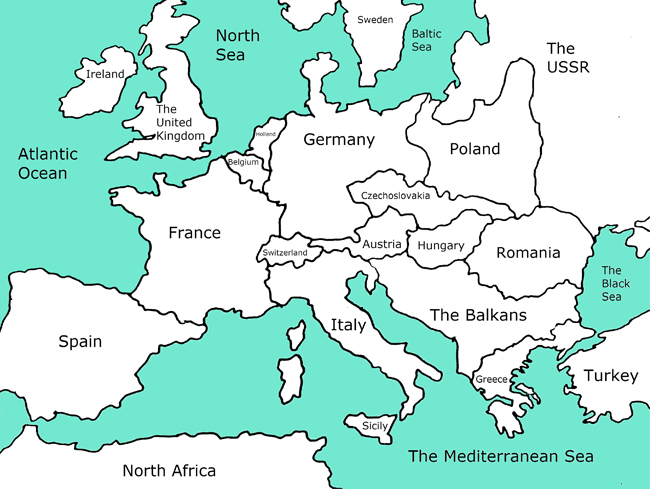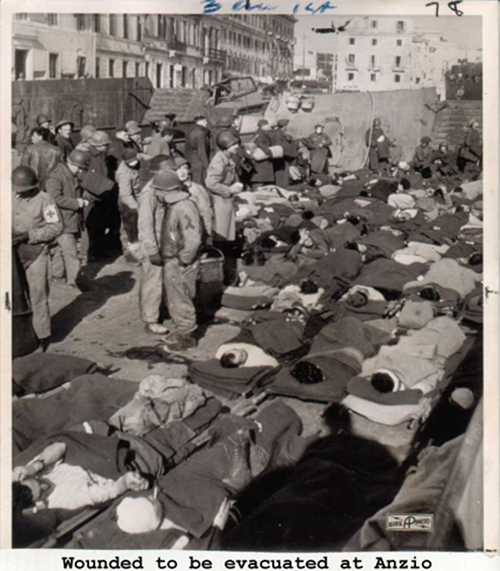
The 45th Infantry Division
Activities
Political Cartoons
A political cartoon is a drawing that uses symbols and images to communicate a message. Some cartoons use words as well, but the image is the focus of a good cartoon. Political cartoons have a long history in newsprint in the United States. There are political cartoons that were drawn during the American Revolution that are still used to communicate messages today.
As a contributor to the 45th Division News and Stars and Stripes, Sgt. Bill Mauldin drew cartoons about the life of the average soldier on the front line. These cartoons were able to communicate to the public the life of a soldier better than written reporting. They also helped soldiers have a laugh during hard times and keep up morale. Here is an example of one of Sgt. Mauldin's cartoons:

(Image courtesy of the Library of Congress.)
Study the image and answer the following questions:
- What do you see in this image?
- How does this image make you feel?
- Can you tell what the message is? Hint: S-2 is the army designation for Military Intelligence Officer in a unit.
- What parts of the cartoon tell you what the message is?
Try drawing your own cartoon on this page. If you like, use this message as a guide:
Front line soldiers don't always get enough sleep.
Here is Sgt. Mauldin's cartoon conveying that same message:

(Image courtesy of the Library of Congress.)
What is different about your drawing? What is the same?
European Geography

This map shows Europe in 1937, before the war. The borders may look a little different than you are used to. Use colored pencils or crayons and the attached map to learn what Europe looked like, where the 45th Infantry Division fought, and which countries fought together or were occupied during World War II.
First, mark all of the countries where the 45th fought by outlining them in red. The 45th fought in:
- Sicily
- Italy
- France
- Germany
Next, color all of the Axis nations in gray. The Axis Nations were:
- Germany
- Austria
- Italy
- Sicily
By 1940, the Axis countries invaded and occupied many other nations. Color these nations in yellow.
The Occupied Nations were:
- Poland
- France
- Belgium
- Holland
- Czechoslovakia
- Hungary
- Romania
- The Balkans
- Greece
- North Africa
Now, color all the Allied Nations (who fought against the Axis) in green. The Allied Nations in Europe were:
- The United Kingdom
- The USSR
Finally, color the nations that stayed neutral, or didn't fight in the war, in brown. The neutral nations were:
- Sweden
- Ireland
- Spain
- Turkey
- Switzerland
Symbolism and Heraldry
Symbolism is when one image or word stands for, or represents, something else. A good example of this is the American flag. You probably see the flag every day, but here is an image of it if you need a reminder:

The flag stands for the United States of America but each of its pieces stands for something else, too.
- There are fifty stars for each state in the United States and thirteen stripes for the thirteen original colonies.
- The color red stands for valor and bravery.
- The color blue stands for vigilance, perseverance, and justice.
- The color white stands for purity and innocence.
The 45th Infantry division had its own symbol as well, on its shoulder patch. Every unit in the US Army has a shoulder patch to identify it. This is the 45th Infantry's patch:
The shoulder patch stands for the 45th Infantry, but each of its parts stand for something as well.
- The yellow symbol is a Thunderbird. A Thunderbird is an American Indian symbol for power and strength.
- The 45th Infantry was originally a National Guard unit drawn from Colorado, Arizona, Oklahoma, and New Mexico. Each of the four sides of the patch represents one of those four states.
- Red is a symbol of bravery and valor.
- Yellow is a symbol of warmth or energy.

Below is a list of colors and symbols, and what they mean. Use this list to create your own shoulder patch for yourself, your classroom, your school, or your family.
Colors:
Silver/white: truth, sincerity, peace, innocence, purity
Gold: wisdom, generosity, glory, constancy, faith
Black: wisdom, grief, constancy, prudence
Green: Signifies abundance, joy, hope, loyalty
Blue: Signifies loyalty, truth, strength, faith
Red: military strength, warrior, martyr
Purple: temperance, justice, royalty
Orange/yellow: ambition, wealth, power, the sun
Symbols:
Acorn: independence, strength
Dog: courage, loyalty
Dragon: valiant, powerful, fearsome
Deer: peace, harmony
Wolf: tough, hard working
Horse: readiness
Raven: intelligence, cunning
Tree: life
Book: knowledge, wisdom
If you don't see a symbol you like, you can find more symbols at the American College of Heraldry website: http://www.americancollegeofheraldry.org/achsymbols.html
My Shoulder Patch

Primary Source Photo Analysis
Study this photo of some of the wounded from the 45th after the Battle of Anzio in 1943.

(Image courtesy of the 45th Infantry Division.
Discuss the following questions with your class or in small groups:
- What do you think is happening in this photograph?
- Why do you think the person who took this photo thought it was important to capture or preserve this moment?
- How does the photo make you feel about war and the sacrifices of our veterans?
- What questions does this photo leave you with? What do you want to know more about?
Creative Writing Activity: Diary or Journal Entry
After studying the photo of two 45th soldiers below, have students do a free write about their observations and feelings about the piece. Provide the following prompts:
- How old do these men or boys look?
- What is their physical condition? Do they look healthy, properly clothed, happy?
- What task or activity do you think they are performing?
- Why do you think these members of the 45th decided to join the war effort?
Next, have students create a diary or journal entry for one of the men in the photograph. Have them describe what the man is like (their name, how old they are, what they are doing) and their life during WWII as this new character. Be sure to have students write this entry in first person and to include their reasons for enlisting and how they feel about their duties and the war.

(Image courtesy of the 45th Infantry Division.)

